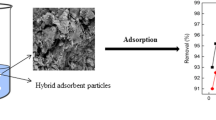Abstract
Silica gel chitosan composite was prepared to perform adsorptive experiment of different heavy metal ion solutions. The characterization of chitosan + silica gel (Ch + Sg) composite was done by FTIR and SEM–EDS to understand the presence of active sites and to have an insight on the surface morphology. The adsorption study of heavy metal ions by Ch + Sg composite gives maximum removal percent for Cu, Pb and Ni which were obtained at pH 5 and for Hg at pH 6.The trend of removal by Ch + Sg signifies that maximum removal percent was attained at 120 min. The surface of Ch + Sg is heterogeneous for the adsorption of Hg, Ni and Cu and homogeneous for Pb adsorption. The values obtained for Pb signify that its adsorption best fitted to pseudo first order with the R2 value of 0.986, whereas pseudo second order best fitted to the experimental data of Cu, Ni and Hg as R2 values which are 0.983, 0.819 and 0.957 respectively. The values of change in entropy (⊿S) obtained for Pb, Cu, Ni and Hg are − 69.33, − 118, − 63.33 and − 98.52 J/mol K respectively. Negative values of change in enthalpy, ⊿H in (kJ/mol) are in the range of − 18.2 to − 37.66 which indicates both physical and chemical adsorption involves in the process of adsorption.



Similar content being viewed by others
References
Chiou, M. S., & Li, H. Y. (2003). Adsorption behavior of reactive dye in aqueous solution on chemical cross linked chitosan beads. Chemosphere, 50, 1095–1105.
Fang, G. Z., Tan, J., & Yan, X. P. (2005). An ion-imprinted functionalized silica gel sorbent prepared by a surface imprinting technique combined with a sol–gel pro-cess for selective solid-phase extraction of cadmium (II). Analytical Chemistry, 77, 1734–1739.
Gandhi, M. R., & Meenakshi, S. (2012). Preparation and characterization of silica gel/chitosan composite for the removal of Cu(II) and Pb(II). International Journal of Biological Macromolecules, 50, 650–657.
Jayakumar, R., Menon, D., Manzoor, K., Nair, S. V., & Tamura, H. (2010). Biomedical applications of chitin and chitosan based nanomaterials— a short review. Carbohydrate Polymers, 82, 227–232.
Kumar, R., Barakat, M. A., Daza, Y. A., Woodcock, H. L., & Kuhn, J. N. (2013). EDTA functionalized silica for removal of Cu (II), Zn (II) and Ni (II) from aqueous solution. Journal of Colloid and Interface Science, 408, 200–205.
Kushwaha, A. K., Gupta, N., & Chattopadhyaya, M. C. (2012). Adsorption behavior of lead onto a new class of functionalized silica gel. Arabian Journal of Chemistry.
Manzoor, K., Ahmad, M., Ahmad, S., & Ikram, S. (2019). Removal of Pb(II) and Cd(II) from wastewater using arginine cross-linked chitosan–carboxymethyl cellulose beads as green adsorbent. RSC Advances, 9, 7890–7902.
Muzzarelli, R.A.A., Boudrant, J., Meyer, D., Manno, N., DeMarchis, M. And Paoletti, M.G. 2012. Current views on fungal chitin/chitosan, human chitinases, food preservation, glucans, pectins and inulin: a tribute to Henri Braconnot, precursor of the carbohydrate polymers science, on the chitin bicentennial. Carbohydrate Polymers. 87:995–1012.
Nandi, B. K., Goswami, A., & Purkait, M. K. (2009). Removal of cationic dyes from aqueous solutions by kaolin: kinetic and equilibrium studies. Applied Clay Science, 42(3–4), 583–590.
Slejko, F. 1985. Adsorption technology: a step by step approach to process. Eva. Appl. New York: Marcel Dekker.
Unuabonah, E. I., Adebowale, K. O., Olu-Owolabi, B. I., Yang, L., & Kong, L. X. (2008). Adsorption of Pb(II) and Cd(II) from aqueous solution onto sodium tetraboratemodified kaolinite clay: equilibrium and thermodynamic studies. Hydrometallurgy, 93, 1–9.
Wu, S. P., Dai, X. Z., Kan, J. R., Shilong, F. D., & Zhu, M. Y. (2017). Fabrication of carboxymethyl chitosan–hemicellulose resin for adsorptive removal of heavy metals from wastewater. Chinese Chemical Letters, 28, 625–632.
Zhou, L., Wang, Y., Liu, Z., & Huang, Q. (2009). Characteristics of equilibrium, kinetics studies for adsorption of Hg (II), Cu (II), and Ni (II) ions by thiourea modified magnetic chitosan microspheres. Journal of Hazardous Materials, 161, 995–1002.
Author information
Authors and Affiliations
Corresponding author
Additional information
Publisher’s note
Springer Nature remains neutral with regard to jurisdictional claims in published maps and institutional affiliations.
Rights and permissions
About this article
Cite this article
Joshi, S., Srivastava, R.K. Adsorptive removal of lead (Pb), copper (Cu), nickel (Ni) and mercury (Hg) ions from water using chitosan silica gel composite. Environ Monit Assess 191, 615 (2019). https://doi.org/10.1007/s10661-019-7777-5
Received:
Accepted:
Published:
DOI: https://doi.org/10.1007/s10661-019-7777-5




